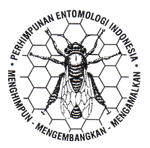Toksisitas beberapa jenis fungisida komersial pada serangga penyerbuk, Trigona (Tetragonula) laeviceps Smith
DOI:
https://doi.org/10.5994/jei.14.1.29Keywords:
dithiocarbamate, Hazard Quotient, LD50, propamocarb HCl, triazoleAbstract
Fungicide is one of the common pesticide applies in agriculture. Even though fungicide is specifically designed to prevent growth of fungi, some studies reported neurotoxic effects of fungicide to some tested animals. Therefore there are concerns about the possible determintal effects of fungicide to beneficial non target organisms, like pollinating insects. This study was conducted to determine the toxicity of commercial fungicide to pollinator, Trigona (Tetrgonula) laeviceps Smith, by determining the LD50 and hazard quotient (HQ). The fungicides tested were triazole (tridimefon and difenoconazole), propamorcab (propamocarb HCl), and dithiocarbamate (mancozeb and propineb). Forager bees were collected and anasthesized by exposing the bees to low temperature (-10 oC) for 1 min. About 1 µl of tiadimefon (6,25; 12,5; 25; 37,25; 50 µg/bee), difenoconazole (1,25; 2,5; 5; 6,25; 12,5; 25 µg/bee), propamocarb HCl (72.,25; 144,5; 216,6; 361,25; 433,5 µg/bee), mancozeb (1,6; 3,2; 4,8; 6,4; 8 µg/bee), and propineb (0.9; 1.8; 2.7; 6; 8.4; 16.8; 25.2 µg/bee) were applied using topical application on dorsal area of bees. Ten bees were used for each concentration and replicated 3 times. Mortality of bees was recorded for 48 hours. Results showed that LD50 and HQ for each tested fungicide were as follow: triadimefon LD50 13.43 ±1.78 µg/bee, HQ = 18.62; difenoconazole LD50 9.25 ± 1.21 µg/bee, HQ = 27.03; propamocarb HCl LD50 270.45 ± 19.48 µg/bee, HQ = 14.34; mancozeb LD50 3.75±0.47 µg/bee, HQ = 512; and propineb LD50 9.71 ±2.20 µg/bee, HQ = 144.18. Among all 5 tested fungicide, two fungicide, mancozeb and propineb, has intermediate level of toxicity to foragers of T. laeviceps and could produce determintal effect to colony.
Downloads
Downloads
Additional Files
Published
How to Cite
Issue
Section
License
Authors who publish with this journal agree to the following terms:
- Authors retain copyright and grant the journal right of first publication with the work simultaneously licensed under a Creative Commons Attribution 4.0 International License that allows others to share the work with an acknowledgement of the work's authorship and initial publication in this journal.
- Authors are able to enter into separate, additional contractual arrangements for the non-exclusive distribution of the journal's published version of the work (e.g., post it to an institutional repository or publish it in a book), with an acknowledgement of its initial publication in this journal.
- Authors are permitted and encouraged to post their work online (e.g., in institutional repositories or on their website) prior to and during the submission process, as it can lead to productive exchanges, as well as earlier and greater citation of published work (See The Effect of Open Access).








